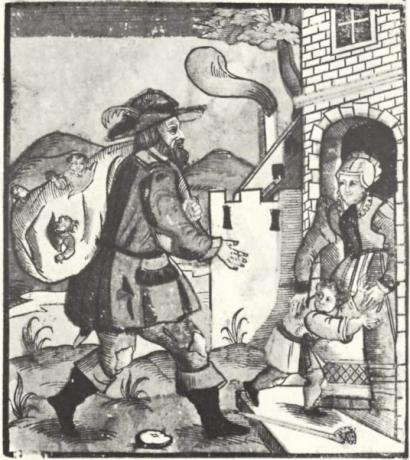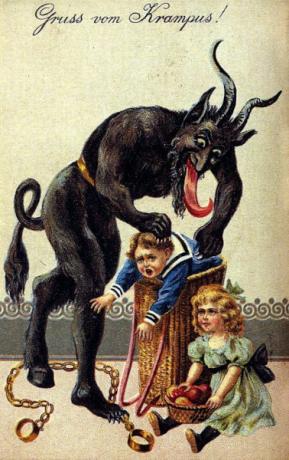O oriole or bag man It can also be called old man, depending on the region of Brazil. His legend has been told all over the world for many centuries. According to her, a being with anthropomorphic characteristics roams the streets carrying a bag, kidnapping children who were disobedient and committing evil acts against them.
The oriole may also be a powerful and sick man, who devours children to cure his illness. A brutal crime committed against a child in 1910, in Spain, may have given rise to the name “papa-figado”, which became popular in the Northeast of Brazil.
Read too: Bogeyman — another figure from popular imagination that still frightens children today
Summary about oriole or sack man
- The legend of the bag man, known in some regions as papa-figo, is part of Brazilian folklore, being one of the most popular legends in the country.
- On every continent, the legend is told of a man with a sack who kidnaps disobedient children, punishing them.
- The Crime of Gádor, committed in 1910, popularized the legend of the bag man and gave rise to the name papa-figado, which in Brazil became papa-figo.
- The oriole is generally represented as a rich man, who suffers from some illness and who, believing that he will be cured, kidnaps children to drink their blood and devour their liver.
What is the legend of the oriole?
The bag man, called in some places oriole,is a being that generally operates at night, kidnapping disobedient children, murdering them, drinking their blood and devouring their liver, hence its name, oriole, oriole.
Often, the oriole is a person of great economic power, who suffers from a disease, such as tuberculosis or leprosy, and who will do anything to try to cure her, including murdering, ingesting the blood and feeding on parts of children's bodies.
What does the oriole look like?
The oriole is described differently across Brazilian territory, but, in all versions, he is represented as a man carrying a sack on his back. He can appear as an ordinary man, usually an elderly man, or as a being with claws and long teeth.
At the beginning of the 20th century, in Brazil, the oriole became associated with people with leprosy, a disease called leprosy at the time. The legend helped to worsen the stigmatization that people with the disease lived with at the time. Câmara Cascudo, one of the main Brazilian researchers of folklore, pointed out that the man with the bag could be described as an old black man, dirty, dressed in rags and who kidnapped children to sell them to rich people who suffered from leprosy.
It could also be described as a pale guy, with unshaven beard and whoattracted children with gifts, like sweets and toys, taking them to remote places, murdering them and later feeding on their blood and liver.
See too:The most famous legends from the North of Brazil
Origin of the legend of the oriole or bag man
Since the Middle Ages, there have been reports of a sack man who captured disobedient children. The legend is still used today to frighten children, making them obey the orders of adults, preventing them from frequenting dangerous places, carrying out actions that could put them at risk or accompanying people Weird.
They existrepresentations of this myth in some 18th century paintings, including that of the German artist Abraham Bach de Ältere. In the work, Ältere composed a man, with a bag full of children, approaching a residence. A child runs to an adult woman, trying to protect herself from this bag man.

He was At the beginning of the 20th century, the bag man also came to be called the oriole. It is believed that This occurred because of a real crime known as the Crime of Gádor. In 1910, in Gádor, Spain, seven-year-old Bernardo González Parra was kidnapped by Francisco Leona. For this, Leona had received money from Francisco Ortega, a rich man who suffered from tuberculosis.
While visiting a healer named Agustina Rodriguez, she informed Ortega that he would only be cured if he ingested the blood of a child and rubbed the fat from it on his own chest. Therefore, Francisco Ortega paid Francisco Leona to kidnap little Bernardo.
Leona made the child unconscious with chloroform and placed him in a jute bag, taking him to her boss's property. As the plan predicted, the boy was murdered, and Ortega drank his blood. The boy's fat was removed and an ointment was made from it and applied to the patient's chest.
After Bernardo's disappearance, the police were notified and ended up finding those responsible for the crime. Francisco Ortega, the boss; Francisco Leona, the man who captured and murdered the boy; and healer Agustina Rodriguez were sentenced to death for the crime. From this event onwards, the man with the bag began to be called the liver-bearer in some places., especially in the Northeast of Brazil, where he became an oriole.
Films about oriole or sack man
In 2018, the Brazilian short film called oriole. The approximately 15-minute short tells the story of two children who are tormented by the Brazilian folklore character. The cast has Chiara Scalett, as Bia; Herbert Richers Jr., as the Bag Man; and Vitor Abate, as Thiago. The short film received several national and international awards.
In 2019, the feature film Haunted Reef, produced by Viu Cine. The film takes place in the capital of Pernambuco, where the main character, Hermano, searches for his brother, facing several characters Brazilian folklore, including the oriole. The film features actors Daniel Rocha, Márcio Fecher, and Rayza Alcântara, and was directed by Adriano Portela.
Know more: Count Dracula — the terrible story behind one of the most famous legends in the world
Curiosities about the oriole and other versions of the legend
- Sack man: The legend of a man or being who captures disobedient children and puts them in a bag to harm them is told across the planet. In English-speaking countries, it is called sack man.
- Krampus: In several regions of Europe, especially in the Alpine regions, the legend of Krampus, character who works together with Saint Nicholas, the Santa Claus. He is an anthropomorphic figure, hairy, with a tail and horns. He punishes children who have not behaved well during the year by beatings or kidnapping. Santa Claus delivers gifts to children who behaved well.

- Robachicos: In Mexican folklore, there is the robachicos, a popular character who closely resembles the bag man. He mainly kidnaps children who don't come home on time or at dinner time.
- Antjie somers: In South Africa, there is the legend of Antjie Somers, which, despite the feminine name, is about a man who, at night, dresses up as a woman to kidnap children. One version of the legend says that he was the executioner of Cape Town and, with the end of slavery, he began to roam South Africa, with a sack on his back, kidnapping children.
Image credits
[1] Wikimedia Commons
Sources
CASCUDO, Luís da Câmara. Brazilian folklore. Editora Global, Rio de Janeiro, 2017.
MAGALHÃES, Basílio de. Brazilian folklore. Editions of the Federal Senate, Brasília, 2006.
NETO, Simões Lopes. Gaucho tales and legends from the South. Editora l&PM, Porto Alegre, 1998.
SANTISTEBAN, Jose Vazquez. The crime of Gador. Anthropo-sociological study. Almería, 1911.
Source: Brazil School - https://brasilescola.uol.com.br/folclore/papa-figo-ou-homem-do-saco.htm

